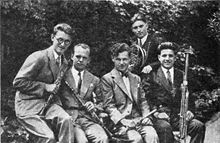
A wind quintet, also known as a woodwind quintet, is a group of five wind players (most commonly flute, oboe, clarinet, French horn and bassoon).
Unlike the string quartet (of 4 string instruments) with its homogeneous blend of sound color, the instruments in a wind quintet differ from each other considerably in technique, idiom, and timbre. The modern wind quintet sprang from the octet ensemble favored in the court of Joseph II in late 18th century Vienna: two oboes, two clarinets, two (natural) horns, and two bassoons.[1] The influence of Haydn's chamber writing suggested similar possibilities for winds, and advances in the building of these instruments in that period made them more useful in small ensemble settings, leading composers to attempt smaller combinations.
It was Anton Reicha's twenty-four quintets, begun in 1811, and the nine quintets of Franz Danzi that established the genre, and their pieces are still standards of the repertoire. Though the form fell out of favor in the latter half of the 19th century, there has been renewed interest in the form by leading composers in the 20th century, and today the wind quintet is a standard chamber ensemble, valued for its versatility and variety of tone color.
- ^ Suppan, Wolfgang. 2001. "Wind Quintet". The New Grove Dictionary of Music and Musicians, second edition, edited by Stanley Sadie and John Tyrrell. London: Macmillan Publishers.